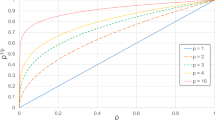Abstract
In Part I of this study (Rozvanyet al. 1989), general aspects of iterative continuum-based optimality criteria (COC) methods were discussed and the proposed approach was applied to structural optimization problems with freely varying cross-sectional dimensions. In this paper, upper and lower limits on the cross-sectional dimensions, segmentation, allowance for the cost of supports and for selfweight, non-linear and nonseparable cost and stiffness functions and additional stress constraints are considered. The examples include beams with various geometrical properties and plates of variable thickness in plane stress. All results are compared with independently derived analytical or semi-analytical solutions and/or with solutions obtained by a mathematical programming (sequential quadratic programming, SQP) method. The number of elements in beam examples is up to one hundred thousand and in plane stress problems up to 3200 elements are used. Comparisons between computer time requirements for the COC and SQP methods are also presented. In addition, the problem of layout optimization is discussed briefly. The paper is intended to establish the power and versatility of the COC method.
Notes. 1. Some less important symbols are defined where they first appear in the text.
2. Nondimensional variables are indicated by the sympbol ~.
Similar content being viewed by others
Abbreviations
- a :
-
half beam-span
- b :
-
width of cross-section
- c :
-
specific cost factor
- k 1,k 2 :
-
factors in stress constraints
- n :
-
number of iterations
- P,p :
-
load vector, load
- q:
-
generalized strain vector
- r :
-
stiffness factor
- s :
-
flexural stiffness
- t :
-
reaction cost factor
- u, ū:
-
real and adjoint displacement vectors
- x :
-
coordinate (beam)
- x, y :
-
coordinates (plate)
- x:
-
spatial coordinates
- z:
-
variable cross-sectional dimensions
- z a ,z b :
-
prescribed minimum and maximum values of a cross-sectional dimension
- A :
-
active element set
- A i :
-
area of elementi
- D :
-
structural domain
- D α :
-
segment
- E :
-
Young's modulus
- G :
-
modulus of rigidity
- I :
-
moment of inertia
- L :
-
span
- [F]:
-
flexibility matrix
- M,\(\bar M\) :
-
real and adjoint bending moments
- N x ,N y ,N xy :
-
stress resultants in plane stress
- P :
-
passive element set
- R:
-
reaction vector
- R d :
-
region controlled by a deflection constraint
- R ℓ :
-
region controlled by a prescribed lowest value of a variable dimension
- R u :
-
region controlled by a prescribed highest value of a variable dimension
- R + σ ,R - σ :
-
region controlled by a flexural stress constraint (with positive or negative moment)
- R + τ , R - τ :
-
region controlled by a shear stress constraint (with positive or negative shear force)
- S ℓ (z, Q) :
-
stress constraints
- V,\(\bar V\) :
-
real and adjoint shear forces
- W i :
-
mutual work of elementi
- γ :
-
specific weight
- δ i :
-
element length
- κ\(\bar \kappa \) :
-
real and adjoint beam curvatures
- λ :
-
Lagrangian (variable)
- v :
-
Lagrangian (constant)
- ω :
-
slack function
- η :
-
slack variable
- ψ :
-
specific cost
- ς\(\bar \zeta \) :
-
real and adjoint generalized shear strains
- v :
-
Poisson's ratio
- Δ:
-
prescribed deflection value
- Φ :
-
total cost (total weight, objective function)
- Ω :
-
reaction cost
- \(\mathcal{G}\) :
-
G-gradient
References
Bendsøe, M.P. 1986: Generalized plate models and optimal design. In: Eriksen, J.L.; Kinderlehrer, D.; Kohn, R.; Lions, J.-L. (eds.)Homogenization and effective moduli of materials and media, the IMA volumes of mathematics and its applications, pp. 1–26. Berlin, Heidelberg, New York: Springer
Bendsøe, M.P. 1989: Optimal shape design as a material distribution problem.Struct. Optim. 1, 193–202
Berke, L.; Khot, N.S. 1988: Performance characteristics of optimality criteria methods. In: Rozvany, G.I.N.; Karihaloo, B.L. (eds.)Structural optimization (Proc. IUTAM Symp. Melbourne, 1988), pp 36–49. Dordrecht: Kluwer
Cheng, K.-T.; Olhoff, N. 1981: An investigation concerning optimal design of solid elastic plates.Int. J. Solids Struct. 17, 305–323
Cheng, K.-T.; Olhoff, N. 1982: Regularized formulation for optimal design of axisymmetric plates.Int. J. Solids Struct. 18, 153–170
Kirsch, U. 1989: On the relationship between structural topologies and geometries.Struct. Optim. 2, 39–45
Rozvany, G.I.N. 1989:Structural design via optimality criteria. Dordrecht: Kluwer
Rozvany, G.I.N.; Gollub, W. 1990: Michell layouts for various combinations of lines supports.Int. J. Mech. Sci. (to appear)
Rozvany, G.I.N.; Olhoff, N.; Cheng, K.-T.; Taylor, J.E. 1982: On the solid plate paradox in structural optimization.J. Struct. Mech. 10, 1–32
Rozvany, G.I.N.; Zhou, M.; Rotthaus, M.; Gollub, W.; Spengemann, F. 1989: Continuum-type optimality criteria methods for large finite element systems with a displacement constraint — Part I.Struct. Optim. 1, 47–72
Venkayya, V.B. 1989: Optimality criteria: a basis for multidisciplinary design optimization.Comp. Mech. 5, 1–21
Zhou, M. 1990:Iterative continuum-type optimality criteria methods in structural optimization. Doct. Thesis, Essen University
Author information
Authors and Affiliations
Rights and permissions
About this article
Cite this article
Rozvany, G.I.N., Zhou, M. & Gollub, W. Continuum-type optimality criteria methods for large finite element systems with a displacement constraint. Part II. Structural Optimization 2, 77–104 (1990). https://doi.org/10.1007/BF01745456
Received:
Issue Date:
DOI: https://doi.org/10.1007/BF01745456




